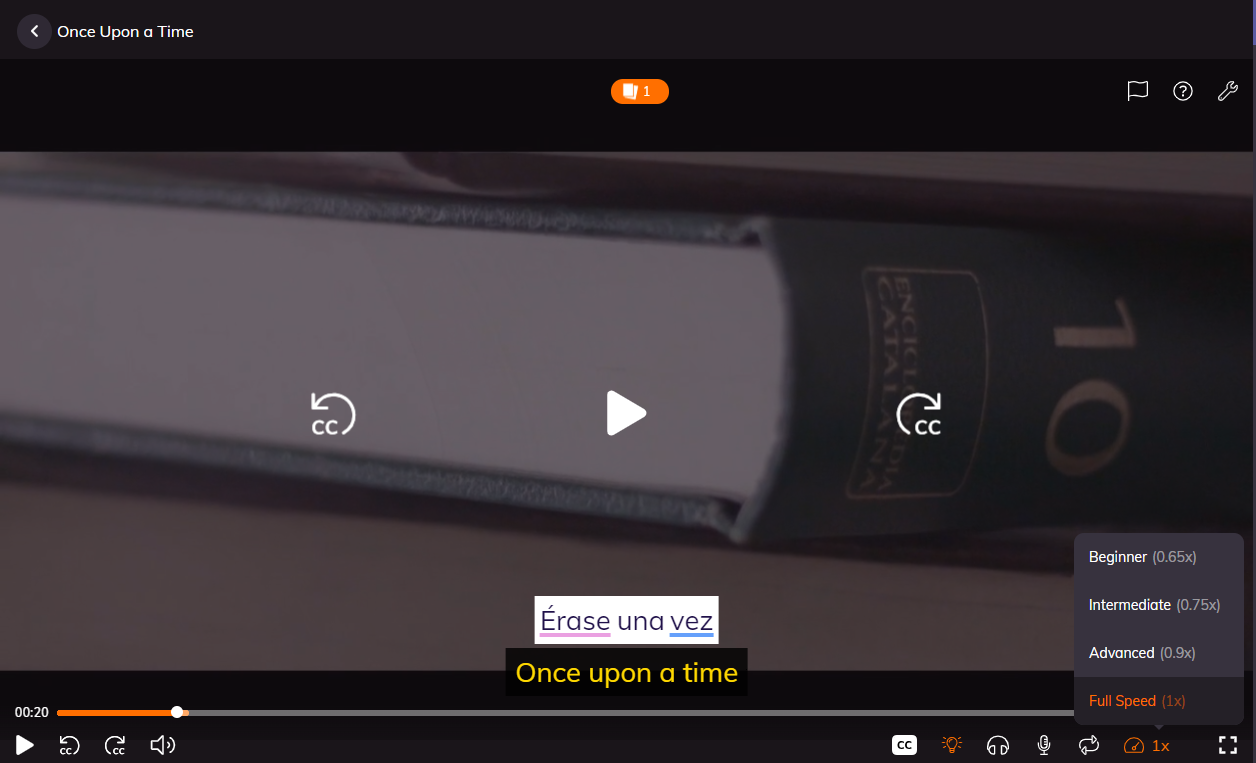Best app to learn Spanish
written by: Krystof-Sandor Harfst
Table of Content
The popularity of learning Spanish is constantly growing - whether out of interest in the culture, for travel planning or for professional development. With over 500 million native speakers worldwide, Spanish is one of the most widely spoken languages in the world. But in our hectic everyday lives, there is often little time for traditional language courses. This is where language learning apps come into play.
Thanks to mobile technologies, we can learn languages in a flexible and personalized way. But with so many apps available, it's hard to choose. Each app has its own methodology, be it game-based learning, interactive exercises or immersive approaches. In this article, we present the best apps for learning Spanish and highlight their advantages and disadvantages. This will help you find the app that best suits your learning style - whether you're a beginner or an advanced learner.
Summary of best app for learning Spanish
Each language-learning app offers a unique approach to learning Spanish, catering to different types of learners and preferences. Here’s a brief summary of what each app excels at:
- Duolingo: Best for beginners looking for a free, gamified, and fun way to learn Spanish without a heavy focus on grammar.
- Babbel: Ideal for learners seeking a structured, grammar-focused approach with lessons designed by experts for real-life conversations.
- Rosetta Stone: Great for serious learners who want an immersive experience without relying on translations and are willing to invest in a premium option.
- Memrise: Suited for those who want to expand their vocabulary in a fun, flexible way with real-life context provided by native speakers.
- Busuu: Perfect for learners who value interaction with native speakers and want a balanced approach that includes community feedback.
- Pimsleur: Best for those who want to improve their speaking and listening skills through an audio-based learning method that can be used hands-free.
Overview of best app for learning Spanish
| Criteria | Duolingo | Babbel | Rosetta Stone | Memrise | Busuu | Pimsleur |
|---|---|---|---|---|---|---|
| Learning Approach | Gamified, bite-sized lessons | Structured, grammar-focused | Immersive, no translation | Vocabulary-focused, real-life context | Structured with community interaction | Audio-based, conversation-focused |
| Content Quality | Varied but repetitive for some users | High-quality, expert-designed | Comprehensive, consistent | High-quality but variable in user-generated content | Expert-designed with native speaker feedback | Consistent and well-structured |
| Grammar Focus | Minimal | Strong | Minimal | Minimal | Moderate | Minimal |
| Conversation Practice | Limited | Strong | Limited | Moderate | Strong (with native speakers) | Very strong |
| Flexibility | High (free and premium versions, short lessons) | Moderate (subscription, structured lessons) | Moderate (premium cost, structured lessons) | High (free and premium versions, flexible courses) | High (offline mode, personalized study plans) | High (audio lessons for hands-free learning) |
| Pricing | Free with ads, premium for ad-free version | Subscription-based, affordable | Premium, higher cost | Free and premium versions available | Limited free version, mostly subscription-based | Subscription-based, higher cost |
| Offline Access | Limited (premium only) | Available | Available | Available | Available | Available |
| Best For | Beginners, casual learners | Learners seeking structured, in-depth learning | Immersive learners, serious commitment | Vocabulary expansion, visual learners | Balanced learners valuing community feedback | Audio learners, busy schedules |
Duolingo
Duolingo is one of the most popular language-learning apps globally, known for its gamified approach to learning. It offers bite-sized lessons that focus on vocabulary, grammar, listening, speaking, reading, and writing, all wrapped in a game-like experience. With its friendly interface and daily streaks, it has become a go-to choice for beginners starting their language-learning journey.
Advantages
- Gamified Learning: Makes the learning process fun and engaging with points, levels, and streaks.
- Free Access: Offers a comprehensive free version with the option to upgrade to Duolingo Plus for an ad-free experience.
- Short Lessons: Lessons are quick and easy, perfect for learning on the go or fitting into a busy schedule.
- Variety of Exercises: Combines listening, speaking, reading, and writing exercises to reinforce learning.
- Community Support: Active forums and community features allow users to discuss topics and seek help from other learners.
Disadvantages
- Limited Grammar Explanations: Provides little in-depth explanation of grammar rules, which can be frustrating for learners seeking a more structured approach.
- Repetitiveness: Exercises can become repetitive over time, which may reduce motivation for some users.
- Lack of Depth for Advanced Learners: Content is primarily geared toward beginners and early intermediates, offering limited value for advanced learners.
- Ads in the Free Version: Frequent ads can interrupt the learning experience unless upgraded to Duolingo Plus.
- Focus on Translation: Over-reliance on translation exercises instead of fostering natural language usage and conversation.
Who It’s Best For
Duolingo is ideal for beginners looking for a fun, gamified way to start learning Spanish. It is particularly suited for casual learners who want to pick up the basics without diving too deep into grammar and advanced language skills.
Babbel
Babbel is a well-regarded language-learning app known for its focus on real-life conversations and grammar. Unlike some other apps that emphasize vocabulary or gamification, Babbel provides structured courses designed by linguistic experts to help learners build a strong foundation in the language. The app offers lessons that cover a range of topics, from everyday conversations to grammar and cultural insights, making it a more comprehensive choice for serious learners
Advantages
- Focus on Grammar and Sentence Structure: Provides clear explanations of grammar rules and sentence construction, which is beneficial for learners who want a deeper understanding of the language.
- Expert-Designed Content: Lessons are created by language experts, ensuring a high-quality, pedagogically sound learning experience.
- Real-Life Conversations: Lessons are centered around practical dialogues that are immediately applicable in real-life situations.
- Offline Access: Lessons can be downloaded for offline use, making it convenient for learning on the go without needing an internet connection.
- Affordable Pricing: Offers various subscription plans that are reasonably priced compared to other language apps, with options for monthly, quarterly, or yearly plans.
Disadvantages
- Limited Free Content: While Babbel offers a small sample of free lessons, most of its content is behind a paywall, which may not appeal to users looking for a free app.
- Structured Learning May Not Suit Everyone: The app's more traditional, structured approach may feel rigid to learners who prefer a more casual or game-like experience.
- Short Lesson Length: Some users find the lessons too short, lacking context or depth for more comprehensive learning.
- Repetitive at Times: Some exercises can feel repetitive, especially in the beginner levels, which might not engage all learners.
Who It’s Best For
Babbel is best suited for learners who are looking for a structured, grammar-focused approach to learning Spanish. It is ideal for those who want to build a strong foundation in the language and are willing to commit to a more traditional learning path with clear explanations and real-life dialogues.
Rosetta Stone
Rosetta Stone is one of the oldest and most respected names in language learning, known for its immersive approach. Instead of relying on translation, Rosetta Stone uses pictures, audio, and text to teach languages, mimicking the way we naturally learn our first language. It emphasizes full immersion from the start, focusing on developing listening, speaking, reading, and writing skills without the use of translations.
Advantages
- Immersive Learning Methodology: Teaches Spanish without using English translations, helping learners think directly in the target language.
- Effective for Pronunciation: Uses speech recognition technology to help learners improve their pronunciation, which is particularly beneficial for speaking skills.
- Consistent and Comprehensive: Provides a structured curriculum that takes learners from beginner to advanced levels.
- Wide Range of Activities: Offers varied activities, including reading, writing, listening, and speaking exercises, ensuring a well-rounded learning experience.
- Mobile and Desktop Access: Lessons are available across devices, and learners can easily switch between desktop and mobile learning.
Disadvantages
- Higher Subscription Cost: Rosetta Stone is more expensive than many other language-learning apps, which might be a barrier for budget-conscious learners.
- Lack of Translation and Explanations: The immersive approach means no direct explanations or translations, which can be frustrating for some learners who prefer more guided learning.
- Limited Focus on Practical Conversations: While it covers all aspects of language learning, some users find that it lacks practical conversation skills needed for real-world interactions.
- Monotonous for Some Users: The repetitive nature of exercises might feel monotonous for learners who thrive on variety and interactive content.
Who It’s Best For
Rosetta Stone is ideal for serious learners who want a thorough, immersive experience and are committed to investing time and money into their language learning. It suits those who prefer a traditional approach without relying on their native language for translations, helping them think directly in Spanish from the start.
Memrise
Memrise combines gamification with a focus on vocabulary and real-world context, making language learning both effective and fun. The app uses a spaced repetition system (SRS) to help learners retain new words and phrases over the long term. Memrise sets itself apart by incorporating video clips of native speakers using the language in real-life contexts, which helps users understand pronunciation, intonation, and cultural nuances.
Advantages
- Spaced Repetition System (SRS): Helps with memory retention by revisiting words and phrases at optimal intervals, which is particularly useful for vocabulary building.
- Native Speaker Videos: Provides real-life video clips of native speakers, which helps learners understand pronunciation, context, and cultural nuances.
- User-Generated Content: Offers a wide variety of user-generated courses, allowing learners to explore different topics beyond the core language lessons.
- Fun and Engaging: Uses game-like elements such as points and leaderboards to keep learners motivated.
- Flexible Learning Options: Offers both free and premium versions, making it accessible to a wide range of users.
Disadvantages
- Less Focus on Grammar: Primarily focused on vocabulary and phrases, with less emphasis on grammar and sentence structure, which may not be enough for learners seeking a more comprehensive approach.
- Quality Variability in User-Generated Content: While there are many user-generated courses, their quality can be inconsistent, potentially leading to gaps in learning.
- Limited Depth for Advanced Learners: Although effective for beginners and intermediates, the content may not be challenging enough for more advanced learners.
- Repetitive for Some Users: The repetitive nature of vocabulary drills might not appeal to all learning styles, particularly those who prefer varied content and exercises.
Who It’s Best For
Memrise is best for learners who want to expand their vocabulary in a fun, flexible way and appreciate seeing the language used in real-life contexts by native speakers. It is particularly useful for beginners and intermediate learners looking to build a solid vocabulary base before diving deeper into grammar and more advanced content.
Busuu
Busuu combines structured language lessons with a strong community-based approach, allowing learners to practice their skills with native speakers. The app offers a range of courses designed by language experts, covering vocabulary, grammar, speaking, and listening. What sets Busuu apart is its interactive community feature, where learners can submit exercises and receive feedback from native speakers, fostering real-world language use and engagement.
Advantages
- Interaction with Native Speakers: Provides a unique platform for learners to practice writing and speaking exercises and receive corrections and feedback from native speakers.
- Personalized Study Plans: Offers customized learning plans based on the user’s level, goals, and time commitment, making it adaptable to individual needs.
- Practical Conversation Skills: Emphasizes speaking and conversation skills, which are crucial for real-world interactions.
- Offline Mode: Allows users to download lessons and study offline, adding flexibility for learning on the go.
- Progress Tracking: Detailed progress tracking helps learners stay motivated and see their development over time.
Disadvantages
- Limited Free Content: The most useful features, such as offline mode and advanced lessons, are locked behind a paywall, limiting the free version’s effectiveness.
- Audio Quality Variability: Some users report inconsistent audio quality in exercises, which can impact the learning experience.
- Overwhelming Interface for Beginners: The amount of content and options available can feel overwhelming for new users who may not know where to start.
- Lack of Immersive Content: Compared to other apps that use immersive techniques, Busuu relies more on traditional lessons and exercises.
Who It’s Best For
Busuu is perfect for learners who value interaction with native speakers and prefer a balanced approach that includes structured lessons, practical conversation skills, and community feedback. It is particularly suited for those who are serious about learning Spanish and want a more social, engaging experience.
Pimsleur
Pimsleur is a renowned language-learning app that focuses primarily on audio-based learning. Developed by Dr. Paul Pimsleur, the method emphasizes listening and speaking skills through immersive audio lessons that require learners to participate in conversations from the very beginning. This approach is highly effective for those who want to improve their conversational abilities and pronunciation, especially when learning on the go.
Advantages
- Emphasis on Speaking and Listening: Prioritizes listening comprehension and speaking skills, making it ideal for learners who want to develop conversational proficiency quickly.
- Hands-Free Learning: Audio-based lessons can be completed while driving, exercising, or doing other activities, making it convenient for busy learners.
- Gradual Learning Approach: The lessons are structured to gradually increase in difficulty, ensuring a solid foundation and retention.
- Effective for Pronunciation: Repetition and spaced recall techniques help improve pronunciation and memory retention.
- Suitable for All Levels: Offers a comprehensive curriculum that takes learners from beginner to advanced levels.
Disadvantages
- Higher Cost Compared to Other Apps: Pimsleur's subscription model is relatively expensive, which can be a drawback for budget-conscious learners.
- Limited Focus on Reading and Writing: The app is heavily focused on audio learning, which means it lacks comprehensive exercises for reading and writing skills.
- Not Very Interactive: Some learners may find the purely audio-based approach monotonous and prefer a more interactive or visual learning experience.
- Lack of Grammar Explanations: While effective for building conversational skills, it provides minimal explicit instruction on grammar rules.
Who It’s Best For
Pimsleur is best for learners who want to develop strong speaking and listening skills quickly and prefer an audio-focused learning approach. It is particularly useful for those who have busy schedules and want to learn hands-free, such as during commutes or while multitasking. It is most effective for beginners to intermediate learners who prioritize conversational proficiency over reading and writing.
Share this article!






